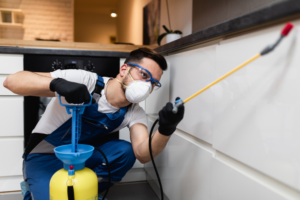Rodents can eat through wires, destroy insulation and cause costly property damage. Plus, sightings of rats and mice in the workplace can tarnish a business’ reputation.
Keep facilities clean by keeping food waste and garbage in rodent-proof containers, emptying trash bins regularly and sanitizing spaces like behind appliances. Also, scrutinize exterior entry points with a keen eye, sealing any cracks or holes — an adult mouse can squeeze through an opening the size of a dime! Contact Commercial Rodent Control now!

Rodents breed rapidly, and even a single pair can cause significant damage in short order. Taking preventive steps, however, can greatly decrease the likelihood of a commercial rodent infestation. A pest control professional can provide a number of preventive techniques including visual inspections to identify potential entry points, sanitation recommendations and the installation of monitoring traps. In addition, they can also provide ongoing pest control services to remove a commercial infestation and keep it from returning.
The most effective preventive measure is to keep a store as clean as possible. This will reduce the food and water available for rats and other rodents in the vicinity of the store. Routine cleaning and trash removal should be accompanied by regular inspections for signs of rodent activity such as urine, feces and gnaw marks. Store employees should also pay attention to unusual sounds or odors in the building, as these may indicate that a rat infestation is in progress.
Store owners should also keep outdoor areas and indoor spaces free of crumbs, dripping pipes, garbage, cluttered areas and debris piles. The best way to do this is by implementing a comprehensive sanitary management program that combines frequent inspections, sanitation and hygienic maintenance.
Stores should also ensure that materials entering the facility are not contaminated with insect larvae, as these can lead to contamination of packed foods. To this end stores should regularly inspect shipping-receiving areas and storage areas, as well as parking garages for insects. If an infestation is detected, the area should be cleaned immediately to avoid contamination of packaged products. In addition, store employees should use monitoring traps to monitor rodent activity in hard-to-reach areas like wall and ceiling voids, attics, crawlspaces, and sub-slab spaces. Alternatively, an experienced pest professional can install a barrier system that creates an impermeable barrier to rodents and other nuisance wildlife. This is an efficient, long-term, chemical-free method of preventing pests from invading a space and disrupting business operations.
Signs of an Infestation
Rodents are a major concern for commercial properties and can cause significant damage. They also carry germs and contaminate food supplies. Additionally, they can chew through wires and other materials in a facility. These problems can affect a company’s reputation, which is especially important for businesses in the food service industry.
Rodents can enter a building through the smallest of openings, making it challenging for owners and staff to determine if there is a problem. Often, the first clue is hearing strange noises, such as scratching or scurrying, at night. These sounds could indicate that rodents are living inside a wall or crawl space.
Other indicators of a rodent infestation are droppings and urine. Rodents leave pellet-like droppings in dark places. They also leave a distinctive urine trail, which is darker and wetter than human foot prints.
In addition to these signs, it’s a good idea for businesses to keep food, trash and other items in rodent-proof containers indoors and outdoors. They should also clean up the facility frequently, and regularly empty and scrub all trash bins both indoors and out. It’s a good idea to use metal bins rather than plastic ones, because mice and rats can chew through plastic and can fit into smaller holes.
Another sign of a rat or mouse infestation is finding chewed, gnawed or damaged goods. Rodents are omnivorous and will eat almost anything, including paper, cardboard, insulation, cloth, wood, electrical wires, furniture, books, clothing, and more. They will also chew through ductwork and pipes.
Finally, look for entry points into the business’s exterior walls and roof. Make sure to inspect areas where the walls meet the foundation, where shingles are on the roof, and the areas around windows and doors. An adult rat can squeeze through an opening the size of a pencil, so it’s important to be vigilant in looking for these small gaps and cracks. A professional rat and mouse exterminator can help seal these entry points to prevent rodents from entering the facility. They can also set up bait stations, which are filled with poison that is disguised as rodent food, to stop the infestation before it gets out of hand.
Exclusion Methods
The best way to prevent rodent infestations is by preventing them from entering your facility in the first place. Rodents chew, gnaw and cause damage to facilities and equipment and can spread disease in the process.
A comprehensive pest management program that incorporates time-tested exclusion methods is an essential part of a successful Integrated Pest Management (IPM) plan. This includes pest-proofing to physically block entry points, modifying sanitation and cleaning protocols, and training employees in reducing conducive conditions that can lead to infestations.
Commercial pest control experts agree that excluding rodents from buildings in the first place is the most cost-effective, safest and longest-term method for controlling them. Exclusion involves the repairing, sealing and shutting down common entry points for pests such as cracks in foundations, gaps around doors and windows, and vents and utility lines that enter buildings. A thorough indoors and outdoors inspection can pinpoint these vulnerabilities.
Professionally installed caulks and sealants can fill in and repair these vulnerable areas. Door sweeps and weather stripping that are properly fitted and secured can also stop rodents from accessing interior spaces. In addition, removing food sources from indoor and outdoor spaces can help deter these rodents from making their way into your business.
Another key component of commercial pest exclusion is a consistent and thorough garbage collection and storage routine. Stored foods should be kept in airtight containers and trash bins should have tight-fitting lids, and outdoor waste cans should be stored away from the building. Clutter and crumbs in kitchens, pantries and storage areas can also attract rats and mice.
In this PCT Business Boosters webinar, our expert Rodent Specialists, Matt Frye and Jim Frye, discuss how to prevent rodents from chewing through electrical wires, plumbing, conduits and outdoor equipment. These simple steps can significantly reduce your rodent problem.
Contact Us
Rodents are a nuisance for homeowners, but they’re equally unwelcome in commercial settings. From restaurants and hotels to hospitals and office buildings, even the cleanest of businesses can become infested with rodents. The pests infiltrate structures through the smallest openings, and quickly cause damage inside and out. Taking proactive measures like routine inspections and trapping ensure that any infestation is dealt with quickly, minimizing disruption to business operations.
In addition to structural damage, rats and mice are known carriers of diseases, including Hantavirus and Salmonella. These illnesses can be transmitted to people through direct contact or by eating contaminated food. Many states have laws requiring that restaurants and other food-centric businesses adhere to strict sanitation standards in order to prevent the spread of disease. Rodents have a strong sense of smell and are attracted to open food containers, spills, and trash that isn’t properly stored or disposed of. They also infiltrate ductwork and pipes, causing water damage and flooding to the interior of businesses.
Rodents gnaw through almost anything, including wires inside walls, leading to electrical problems and posing a fire hazard. They can also contaminate surfaces with their droppings, urine and hairs. These contaminants exacerbate allergies and asthma in sensitive people, and can make workplaces uncomfortable for employees.
An experienced and professional commercial pest control company will help you prevent an infestation with a variety of methods, including rodent exclusion. They can also conduct a thorough inspection of the property, looking for entry points along the exterior of your business establishment. Indoors, trapping and bait can be used to capture rodents and reduce populations. In addition, a trained technician can offer advice on how to maintain a clean environment and reduce conducive conditions that attract rodents in the first place. Contact us today for more information about our services or to schedule an inspection and estimate. We look forward to helping you keep your business safe and sanitary for your customers and employees.
